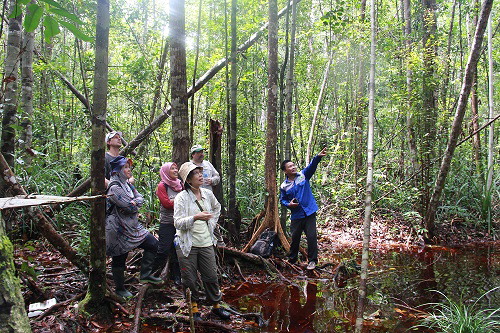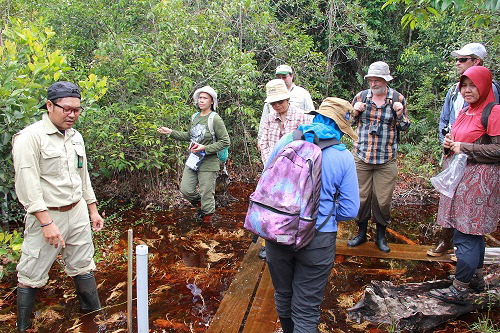Cycle 6 (2017 Deadline)
Developing biodiverse agroforests on rewetted peatlands in Indonesia
PI: Sonya Dewi, s.dewi@cgiar.org, World Agroforestry Centre (ICRAF)
U.S. Partner: Randall Kolka, USDA Forest Service Northern Research Station
Project Dates: December 2017 - December 2021
Project Overview
The policy on peatland restoration in Indonesia is to rewet, requiring a minimum water table of 40 cm below the surface, to avoid future fire and haze episodes. Although rewetting is the most logical and effective means for restoring and conserving the biophysical condition of peatlands, the social and economic perspectives are overlooked. Four constraints to effective tropical peatland management (van Noordwijk et al., 2015) are (1) lack of scientific understanding of peatland and vegetation responses; (2) unwillingness to act by the national and local governments; (3) inability to act within existing legislative and economic realities; and (4) lack of attractive land-use options for smallholders and communities living on the edges of peatlands. With Indonesia’s new restoration policies, significant progress has been made to relieve constraints 2 and 3, but the primary constraints have shifted to 4 and associated parts of 1. This project aims to fill knowledge gaps through rigorous research assessing vegetation responses to drainage and rewetting in a range of disturbed peatland conditions, as current information is not sufficient to evaluate restoration options that have an economic return through utilizing valuable vegetation and fish. A plant ecological (functional traits) approach will be applied to focus on root-system adaptations to survive in wet conditions. Concurrently, the researchers will interview smallholders and the broader community to assess local knowledge, perceptions and preferences for peatland restoration economic development using well-established methods for participatory research.
Specific objectives include (1) assessing the richness and composition of peatland tree and plant species; (2) evaluating assess plant functional attributes in response to rewetting; (3) determining the domestication and adoption potential of adapted species; and (4) synthesizing and providing advice for policy and practice. The U.S. partners will provide guidance on study design, restoration methods, and vegetation options and help with data interpretation and publication across all aspects of the work. Expected outputs will be (1) options for peatland restoration that lead to local economic sustainability; (2) scientific publications and a database that can be leveraged for future studies; and (3) synthesis publications developed specifically to inform policymakers and practitioners that can be broadly used to advise peatland restoration actions regionally and nationally. More widely, the team’s results should inform those involved in peatland restoration, including private, industrial and governmental sectors, to gain a better understanding on choices of species for economic gain and potential for further domestication. This can inform extension programs being set up to assist smallholders and communities restore peatlands. The researchers will provide policymakers and executing agencies for peatland restoration evidence-based information on the potential species and practices for restoration that can improve local livelihoods in a range of land-use options.
 |  | | The project team on a field visit to the peatlands | The team measures the water table in Sebangau (photos courtesy of Dr. Dewi). |
Final Summary of Project Activities
This project’s main goal was to find new evidence through research that can support peatland restoration with rewetted techniques through agroforestry systems, specifically in Central Kalimantan. The expected outcome is the use and adoption of the lessons learned in peatland restoration strategies in other locations in Indonesia or other tropical peatlands areas. The research team carried out their work in four thematic areas:
Thematic Area 1: Assessment of the richness and composition of peatland tree and plant species
The researchers found a weak correlation between rewetting and the natural regeneration of native tree species in the disturbed peatland areas studied. Natural regeneration is affected by the degradation level of the areas and prevalence of wildlife as seed dispersers of the native peatland species. The study found 60-80% of the tree species in rewetted peatlands are dispersed by animals. In more degraded peatlands, wind-dispersed species predominate. Thus, to support the regeneration of native trees in the areas where revegetation is being promoted in rewetted peatland areas, planners should also prioritize the planting of tree species that are dispersed by animals, such as fruit species. Planting fruit trees will provide food for wildlife like birds and primates (orangutans), which in turn helps the natural regeneration of native peatland species in the areas. Specific outputs from this thematic area include - Three theses by undergraduate students from Palangkaraya University
- A paper jointly authored with the project’s U.S. partners and submitted to an international journal (publication pending at time of final report)
- A tree inventory dataset (species list from seedlings, saplings, and trees stages, peat depths, plot history) from a total of 48 plots in Mangkok Resort and CIMTROP Peatland Natural Laboratory (LAHG).
Thematic Area 2: Assessment of plant functional attributes in response to rewetting
Functional traits studied consisted of growth rate, wood density, shoot root ratio, hydraulic conductivity, xylem structure, and presence of lentisel, which can be used to differentiate the tolerance level of species to waterlogging and shaded conditions. The researchers found that the fast-growing timber tree species sengon is not suitable to be planted on peatland. Sengon growth in peatland was influenced by peat depth and peat maturity, but the team’s data showed that the species grows poorly in such environments. These findings should be useful in convincing government agencies not to develop a sengon plantation program in peatlands. Specific outputs include
- Nine theses by undergraduate students from IPB University
- A published peer-reviewed article in the journal Sustainability: Assessment on the Suitability of Planting Non-Native Peatlands Species Falcataria moluccana (Miq.) Barneby & Grimes in Rewetted Peatlands.
- A paper co-authored with the U.S. partners and submitted to an international journal (publication pending at time of final report)
- A set of databases on natural tree vegetative successional processes under rewetted conditions in a total of 40 semi-permanent plots in three locations (TNS, Misik Kameloh, and KHDTK Tumbang Nusa) observed in September 2018, March 2019, October 2019 and July 2020)
Thematic Area 3: Assessment of domestication and adoption potential of adapted species
The utilization of peatland species in the peatland landscape of Pulang Pisau District is influenced by farmers’ perceptions and knowledge of the species. Species with less utilization tend to be disregarded by farmers. Knowledge of the species utilization is influenced by lengths of interaction between farmers with the species. The researchers found, for example, that people of the Dayak ethnicity have better knowledge on species utilization compared to those of the Java ethnicity, a group that has no background history of living in peatland areas. Economic aspects are not the only reason for domesticating particular peatland species. The length of interaction of utilizing species to support local people's livelihood needs (cash and subsistence) is also a major aspect that influences farmers' adoption of peatland species. Most of the recommended peatland species to be planted in the rewetted still have limited domestication techniques and low market potentials. These two major points need further investigation through integrated research from domestication aspects to post-handling techniques that can increase market potentials. Farmers’ knowledge of species domestication techniques of peatland species is still limited. At the moment, they mostly harvest the product from peatland species based on extraction, which may lead to the potential depletion and extinction of specific peatland species with high economic values. Specific outputs under this thematic area include
- Three theses by undergraduate students from Palangkaraya University
- A set of research findings from studies on utilization of peatland species, profitability assessments of peatland agroforestry systems, and market chains of important peatland species in Pulang Pisau District
- A paper published in peer-reviewed journal by a Palangkaraya University lecturer in Journal of Ecological Engineering: Finding Strategies for Peatland Rehabilitation; Agroforestry Systems on Various Types of Peat Depth in Three Villages in Central Kalimantan
- A dataset of interviews with 90 respondents on plant utilization perception of three ethnicities, 30 respondents on the profitability of sago palm, and 30 respondents on market potentials of peatland species; and focus group discussions with three communities on profitability analysis of establishing diverse agroforestry systems in peatland landscape
Thematic Area 4: Synthesis and dissemination of advice for policy and practice
From the training event they conducted, the research team found evidence that farmers’ knowledge on the suitability and economic and environmental benefits of peatland native species is an important aspect for the adoption of suitable tree species to be planted in rewetted peatland agroforestry systems. Currently, there are limited extension services provided to farmers to improve their understanding of how to select appropriate species that can provide economic benefits for their livelihood while producing environmental benefits to the landscape in rewetted peatlands areas. Specific outputs from this thematic area include
- A training event to share research results from the study with farmers and research agencies in Jabiren Raya Subdistrict, Pulang Pisau District, Central Kalimantan Province
- A draft of a field guide for establishing agroforestry under rewetted peatland and other peatland landscape characteristics
- A draft of a policy brief on rewetted peatland agroforestry
Overall, the PI Dr. Sonya Dewi summarizes the impacts of her project as noted below. Thanks for approximately $18 million in new grants funds she and her team have subsequently obtained, they are in an excellent position to build further on their results from the PEER project.
- Increased understanding of essential elements for selecting species to be integrated into rewetted peatland agroforestry systems, as well as increased awareness by farmers of these selection criteria.
- Increased awareness of universities and other research agencies of research gaps to support rewetted peatland strategies for restoration.
- Capacity building and development of networks between Indonesian researchers and U.S. researchers on tropical peatlands and strategies for their restoration.
- Capacity building through knowledge exchange and development of networks between Indonesian researchers from different institutions, i.e., Palangkaraya University located in the peatland landscape, FRDC with its research stations distributed across the country, and the international research institution ICRAF, which has a large country program in Indonesia and other country programs across the tropics, allowing for south-south cross-fertilization of ideas and lessons learned.
- Improved understanding of peatland restoration strategies by policy-makers at the local level in Pulang Pisau District and national level in Indonesia.
Publications
Rotinsulu, J. M., Afentina, A., Yanarita, Y., Indrayanti, L., Nursiah, N., Dewi, S. (2022). Finding Strategies for Peatland Rehabilitation; Agroforestry Systems on Various Types of Peat Depth in Three Villages in Central Kalimantan. Journal of Ecological Engineering, 23(2), 150-158. https://doi.org/10.12911/22998993/144422
Nuroniah, H.S., Tata, H.L., Mawazin, Martini, E., Dewi, S. (2021). Assessment on the Suitability of Planting Non-Native Peatlands Species Falcataria moluccana (Miq.) Barneby & Grimes in Rewetted Peatlands. Sustainability 2021, 13(13):7015. https://doi.org/10.3390/su13137015
Back to PEER Cycle 6 Grant Recipients
|





